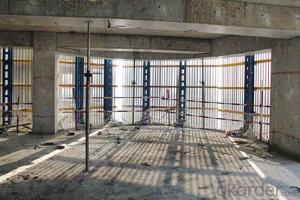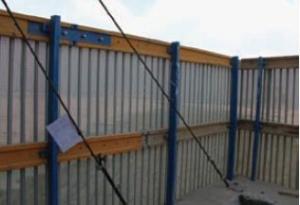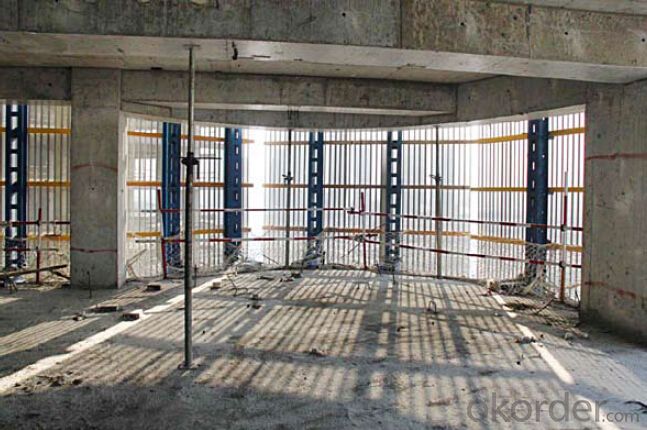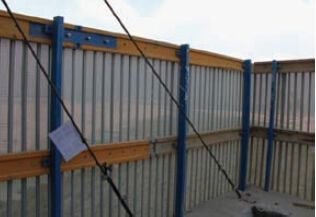Protection Platform for Formwork and scaffolding systems
- Loading Port:
- Tianjin
- Payment Terms:
- TT OR LC
- Min Order Qty:
- 50 m²
- Supply Capability:
- 1000 m²/month
OKorder Service Pledge
OKorder Financial Service
You Might Also Like
Protection Platform PP-50
A kind of new type construction protection system, applying operating platform and safer job
location for construction corps.
Characteristics:
◆ Easy and quick assembling.
◆ Lifted as a group, it is rapid and economic.
◆ Auto-climbing
◆ A safe and reliable anchor system
1. Composition
2. Assembly process of anchor system
(1) Embed V-climbing cone and anchor plate into the slab.
(2) Fix anchor shoe on the slab by tensile bolt.
(3) The fixed anchor shoe.
◆ High work efficiency with work platform and unload platform
◆ High light transmittance with the hollow block
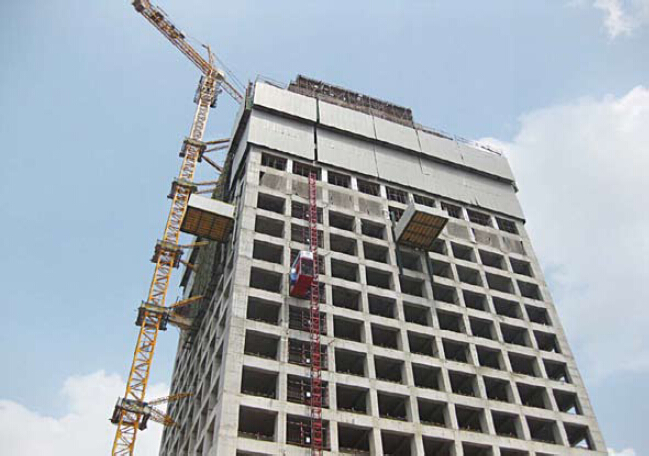

- Q: Can steel formwork be used in seismic areas?
- Steel formwork is indeed applicable in seismic regions due to its strength, durability, and stability. Its ability to endure the forces and vibrations produced during an earthquake guarantees the safety and stability of the structures under construction. Moreover, the quick construction facilitated by steel formwork is advantageous in seismic areas where timeliness is crucial for ensuring the security of the built environment. Nevertheless, it is vital to ensure that the steel formwork is correctly designed and installed to meet the area's specific seismic design requirements and codes.
- Q: How does steel formwork handle concrete setting time and curing temperature?
- Due to its exceptional heat transfer properties and durability, steel formwork is highly preferred for managing the concrete setting time and curing temperature. The excellent heat conduction of steel aids in dissipating the heat produced during the hydration process of concrete, thereby expediting its setting time. This enables a quicker construction process and reduces the overall project duration. Moreover, steel formwork possesses the capability to endure elevated curing temperatures without distorting or deteriorating. This becomes particularly crucial in situations where high-temperature curing is necessary to attain the desired strength and durability of the concrete. Steel's resilience against high temperatures guarantees that the formwork remains intact and steady, providing essential support to the concrete throughout the curing process. Additionally, the strength and rigidity of steel formwork prevent any deformation or movement during the concrete setting and curing phases. This plays a vital role in maintaining the desired shape, size, and surface finish of the concrete structure. By employing steel formwork, the concrete remains securely in place and avoids any undesirable shifts or displacements during the curing process. In conclusion, steel formwork is an optimal choice for managing concrete setting time and curing temperature due to its exceptional heat transfer properties, ability to withstand high temperatures, and its strength and rigidity. Its utilization facilitates accelerated setting times, enables high-temperature curing, and guarantees the stability and integrity of the concrete structure during the curing process.
- Q: What are the main components of a steel formwork system?
- The main components of a steel formwork system typically include panels, connectors, clamps, pins, and wedges.
- Q: Are there any specific maintenance requirements for steel formwork?
- Steel formwork has specific maintenance requirements that must be followed to ensure its optimal performance and durability. Cleaning the formwork after each use is crucial. This involves thoroughly removing any concrete residue and preventing the accumulation of corrosive agents. A mild detergent and water can be used for cleaning, followed by proper drying of all surfaces. Inspecting the formwork for any signs of damage or wear is also important. This includes checking for cracks, rust, or any other defects that could weaken the structure. Prompt repair or replacement of damaged components is necessary to maintain the formwork's integrity and safety. Proper storage and handling practices are essential for steel formwork maintenance. The formwork should be stored in a dry and well-ventilated area to prevent corrosion. Protection from moisture, extreme temperatures, and direct sunlight is necessary. When handling the formwork, abrasive materials or tools that could cause scratches or dents should be avoided. Regular lubrication of moving parts, such as hinges and locks, is recommended. This ensures smooth operation and prevents seizing or jamming. Using a suitable lubricant reduces friction and extends the life of these components. Lastly, it is advisable to follow the manufacturer's guidelines and recommendations for specific maintenance requirements of the steel formwork. These guidelines may include additional steps or precautions that are specific to the formwork system being used. By adhering to these maintenance requirements, steel formwork can be kept in excellent condition, allowing for efficient and safe construction practices.
- Q: How does steel formwork handle different concrete curing methods?
- Steel formwork is renowned for its durability and flexibility, making it ideal for accommodating various concrete curing techniques. Its strength and stability enable it to withstand the pressure exerted by different curing methods, ensuring the formwork remains intact throughout the process. One commonly used concrete curing method is the traditional wet curing method, where the concrete is kept moist by covering it with plastic sheets or wet burlap. Steel formwork easily adapts to this method as it is non-absorbent and resistant to moisture. It effectively prevents water from penetrating the formwork, guaranteeing its longevity and structural integrity. Another curing method involves the application of curing compounds or membranes to the concrete surface. These compounds create a barrier that slows down moisture evaporation, allowing the concrete to cure at a controlled pace. Steel formwork is compatible with curing compounds and membranes, as they can be effortlessly applied and adhered to the formwork surface without causing any damage. Moreover, steel formwork can also withstand accelerated curing methods, such as the application of heat or steam to expedite the curing process. The high strength and heat resistance of steel enable it to endure elevated temperatures during accelerated curing without warping or distorting. This ensures that the formwork maintains its shape and stability, even under extreme conditions. In conclusion, steel formwork is well-suited to accommodate different concrete curing methods due to its durability, resistance to moisture, and heat resistance. Its ability to withstand the pressures and conditions associated with various curing techniques makes it a reliable choice for construction projects that require versatile and robust formwork systems.
- Q: Can steel formwork be used for precast concrete beams?
- Indeed, precast concrete beams can utilize steel formwork. Demonstrating durability and rigidity, steel formwork effectively endures the weight and pressure exerted by the concrete during casting. It furnishes a seamless and uniform surface to facilitate pouring the concrete, guaranteeing the anticipated shape and dimensions of the beam. Moreover, steel formwork enables effortless demolding and reusability, rendering it a financially prudent option for manufacturing precast concrete beams.
- Q: How does steel formwork affect the overall thermal performance of the building?
- Steel formwork does not directly affect the overall thermal performance of the building as it is primarily used in the construction process for shaping and supporting concrete structures. However, if steel formwork is not properly insulated or if there are gaps between the formwork and the concrete, it can contribute to thermal bridging, which can negatively impact the building's energy efficiency.
- Q: Can steel formwork be used for swimming pool construction?
- Yes, steel formwork can be used for swimming pool construction. Steel formwork offers durability and strength, making it suitable for creating the required concrete structure of a swimming pool. It is commonly used in the construction industry for various applications, including swimming pool construction.
- Q: Are there any specific building codes or regulations related to steel formwork?
- Yes, there are specific building codes and regulations related to steel formwork. These codes and regulations are put in place to ensure the safety, stability, and integrity of structures constructed using steel formwork. One of the most widely recognized codes is the International Building Code (IBC), which provides minimum requirements for the design, construction, alteration, and maintenance of buildings and structures. The IBC includes provisions for formwork systems, including steel formwork, to ensure they meet certain standards of strength, durability, and stability. In addition to the IBC, several other organizations and agencies provide guidelines and standards for steel formwork. For example, the American Concrete Institute (ACI) has a document called ACI 347-04, Guide to Formwork for Concrete, which provides recommendations for the use of various types of formwork, including steel formwork. These codes and standards cover various aspects of steel formwork, including design, materials, construction, and inspection. They address issues such as the maximum allowable loads, proper bracing and shoring, formwork connections, and the quality of materials used. They also provide guidance on safety measures, such as fall protection, to ensure the well-being of workers during formwork installation and removal. It is important for builders, designers, and contractors to be familiar with these codes and regulations to ensure compliance and to guarantee the structural integrity and safety of buildings constructed using steel formwork. Local building departments and authorities having jurisdiction can provide specific information and requirements related to steel formwork in their respective regions.
- Q: Can steel formwork be used in bridge construction?
- Yes, steel formwork can be used in bridge construction. Steel formwork refers to the use of steel panels or frames to create the desired shape and structure of a bridge during the construction process. Steel formwork is often preferred in bridge construction due to its durability, strength, and ability to withstand the high loads and stresses that bridges are subjected to. It is capable of withstanding heavy concrete pouring and can be reused multiple times, making it a cost-effective choice for bridge construction. Additionally, steel formwork offers flexibility in design and allows for intricate and complex shapes to be constructed, ensuring the bridge meets the desired specifications and requirements. Overall, steel formwork is a popular choice in bridge construction due to its strength, durability, reusability, and versatility.
Send your message to us
Protection Platform for Formwork and scaffolding systems
- Loading Port:
- Tianjin
- Payment Terms:
- TT OR LC
- Min Order Qty:
- 50 m²
- Supply Capability:
- 1000 m²/month
OKorder Service Pledge
OKorder Financial Service
Similar products
Hot products
Hot Searches
Related keywords
